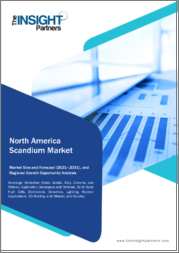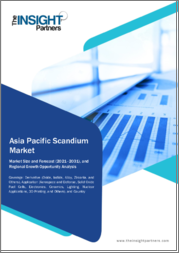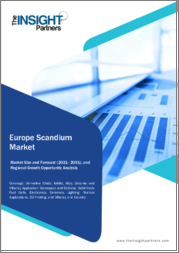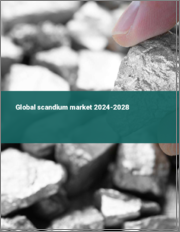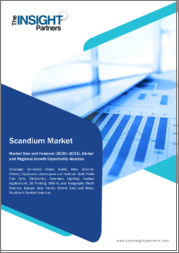
|
시장보고서
상품코드
1831897
스칸듐 시장 보고서 : 제품 유형, 용도, 최종 용도 산업, 지역별(2025-2033년)Scandium Market Report by Product Type, Application, End Use Industry, and Region 2025-2033 |
||||||
세계의 스칸듐 시장 규모는 2024년에 6억 2,880만 달러에 달했습니다. 향후 IMARC Group은 시장이 2033년까지 10억 6,880만 달러에 달하며, 2025-2033년에 6.1%의 성장률(CAGR)을 보일 것으로 예측하고 있습니다. 이 시장은 주로 항공우주 및 자동차 산업에서 경량 고성능 합금의 사용 확대, 전기자동차 시장의 대폭적인 확대, 스칸듐 수입 의존도를 낮추기 위한 유리한 정부 정책에 의해 주도되고 있습니다.
스칸듐 시장 동향
항공우주 및 방위산업 수요
스칸듐의 항공우주 및 국방 분야에서의 응용은 알루미늄 합금의 성능을 향상시키고 경량화, 고강도를 실현하는 특성으로 인해 중요한 역할을 담당하고 있습니다. 이 용도는 보다 효율적인 항공우주 구조물 및 군 장비를 제조하는 데 필수적입니다. 미국 연방항공청(FAA)에 따르면 전체 현역 일반 항공기는 2018년 212,875대에서 2039년 211,575대로 증가할 것으로 예측됩니다. 국방 역량을 혁신하고 향상시키기 위해 스칸듐 합금과 같은 첨단 소재를 도입하는 것이 강조되고 있습니다. 이러한 투자는 스칸듐 강화 재료의 개발을 촉진하고 최신 항공우주 공학 및 방위 시스템의 엄격한 요구 사항을 충족시킬 것입니다. 또한 정부 자금에 의해 촉진되는 지속적인 연구개발은 기술 혁신을 촉진하고 스칸듐의 용도를 확대하여 시장 성장을 가속할 것입니다. 이러한 산업이 연비 효율과 성능을 향상시키기 위해 더 높은 강도 대 중량비를 가진 재료로 전환함에 따라 스칸듐의 가치는 점점 더 중요해지고 있으며, 미래 국방 및 항공우주 개발의 중요한 기반이 되고 있습니다.
전기자동차(EV) 시장 성장
전기자동차(EV) 시장의 확대는 스칸듐 수요를 크게 증가시킬 것입니다. 스칸듐은 다양한 EV 부품용 경량 알루미늄 스칸듐 합금의 제조에 널리 채택되고 있습니다. Global Sustainable Electricity Partnership에 따르면 국영 송전망의 조사에 따르면 중국의 운송 부문 전력 점유율은 2015년 5%에서 2025년 10%, 2030년 15%, 2040년 25%로 증가할 것으로 예측했습니다. 예측했습니다. 또한 중국내 전기자동차 판매량은 2011년 5,600대를 시작으로 2014년에는 4만 5,000대, 2016년에는 74만대까지 확대되었습니다. 2017년까지 중국은 약 77만 대의 EV를 생산하여 총 200만 대의 EV를 보유하게 되었습니다. 2030년까지 중국의 전기자동차 보유량은 5,000만 대에 육박하고, 전기자동차 충전 전용 전력 수요는 연간 200TWh에 달할 것으로 예측됩니다. 중국자동차공정학회에 따르면 2030년 자동차 판매량은 3,800만 대이며, 그 중 1,500만 대(40%)가 전기자동차가 될 것이라고 합니다. 또한 스칸듐 합금은 자동차의 경량화, 배터리 성능 및 효율성 향상에 대한 요구를 충족시킵니다. 이에 따라 미국, 중국, 유럽 연합 등 주요 경제국 정부는 스칸듐 사용을 포함한 기술 발전을 지원하는 한편, 규제와 목표를 통해 전기자동차 판매량 증가를 촉진하고 있습니다. 따라서 이러한 규제 추진과 스칸듐 합금이 제공하는 장점의 조합으로 인해 이 소재는 급성장하는 EV 시장 수요를 충족시키는 데 필요한 중요한 자원의 최전선에 위치하고 있습니다.
정부 지원책
각국 정부는 스칸듐을 중요한 광물로 인식하고 있으며, 스칸듐공급을 확보하고 다양한 산업에서의 활용을 촉진하기 위한 전략적 조치를 시행하고 있습니다. 미국에서는 에너지부가 유럽연합(EU) 및 호주와 공동으로 스칸듐 채굴 능력을 향상시키고 수입 의존도를 낮추기 위한 자금과 보조금을 책정하고 있습니다. 예를 들어 2023년 11월 9일 스칸듐 인터내셔널 마이닝(Scandium International Mining Corp.)은 자회사인 EMC Metals Australia Pty Ltd가 2023년 Nyngan 시추 프로그램의 좋은 결과를 바탕으로 Nyngan 스칸듐 프로젝트의 물리적 개발을 시작했다고 발표했습니다. 물리적 개발을 시작했다고 발표했습니다. 닝안스칸듐 프로젝트는 호주 뉴사우스웨일스주 서부의 닝안에서 남남서쪽으로 17.5km 떨어진 곳에 위치하고 있습니다. 닝안스칸듐 프로젝트는 세계 최초의 스칸듐 전용 채굴 사업으로 호주, 캐나다, 미국 정부가 중요 금속으로 인식하고 있는 수요가 높은 금속에 초점을 맞추었습니다. 이번 개발은 뉴사우스웨일즈주가 책임감 있는 주요 광물 공급의 세계 리더가 될 수 있는 좋은 기회입니다. 따라서 정부의 적극적인 노력은 스칸듐공급을 보장하고 시장을 안정화하며 스칸듐을 첨단 산업과 지속가능한 개발 프로젝트의 최전선으로 끌어올릴 수 있습니다.
목차
제1장 서문
제2장 조사 범위와 조사 방법
- 조사의 목적
- 이해관계자
- 데이터 소스
- 1차 정보
- 2차 정보
- 시장 추정
- 보텀업 어프로치
- 톱다운 어프로치
- 조사 방법
제3장 개요
제4장 서론
제5장 세계의 스칸듐 시장
- 시장 개요
- 시장 실적
- COVID-19의 영향
- 시장 예측
제6장 시장 내역 : 제품 유형별
- 산화물
- 불화물
- 염화
- 질산염
- 옥화물
- 합금
- 기타
제7장 시장 내역 : 용도별
- 알루미늄-스칸듐 합금
- 고휘도 메탈 할라이드 램프
- 레이저
- 고체 산화물 연료전지
제8장 시장 내역 : 최종 용도 산업별
- 항공우주와 방위
- 세라믹
- 조명
- 일렉트로닉스
- 3D 프린팅
- 스포츠 용품
- 기타
제9장 시장 내역 : 지역별
- 북미
- 미국
- 캐나다
- 아시아태평양
- 중국
- 일본
- 인도
- 한국
- 호주
- 인도네시아
- 기타
- 유럽
- 독일
- 프랑스
- 영국
- 이탈리아
- 스페인
- 러시아
- 기타
- 라틴아메리카
- 브라질
- 멕시코
- 기타
- 중동 및 아프리카
제10장 SWOT 분석
제11장 밸류체인 분석
제12장 Porter's Five Forces 분석
제13장 가격 분석
제14장 경쟁 구도
- 시장 구조
- 주요 기업
- 주요 기업의 개요
- Australian Mines Limited
- Galileo Resources PLC
- GFS Chemicals Inc.
- Hunan Oriental Scandium Co. Ltd.
- Lenntech B.V.
- Materion Corporation
- Merck KGaA
- Niocorp Developments Ltd.
- Platina Resources Limited
- Scandium International Mining Corporation
- Sumitomo Metal Mining Co. Ltd
- Thermo Fisher Scientific Inc.
The global scandium market size reached USD 628.8 Million in 2024. Looking forward, IMARC Group expects the market to reach USD 1,068.8 Million by 2033, exhibiting a growth rate (CAGR) of 6.1% during 2025-2033. The market is primarily driven by the growing usage of lightweight, high-performance alloys in aerospace and automotive industries, significant expansion in the electric vehicle market, and favorable government policies to reduce the scandium import dependency.
Scandium Market Trends:
Aerospace and Defense Industry Demand
Scandium's incorporation into aerospace and defense sectors is instrumental due to its attributes that enhance the performance of aluminum alloys, making them lighter and stronger. This application is critical for producing more efficient aerospace structures and military equipment. As per the Federal Aviation Administration (FAA), the overall active general aviation fleet is projected to change from 212,875 aircraft in 2018 to 211,575 by the year 2039. There is a substantial emphasis on incorporating advanced materials like scandium alloys to innovate and improve defense capabilities. These investments boost the development of scandium-enhanced materials as they fulfill the stringent requirements of modern aerospace engineering and defense systems. Furthermore, continuous R&D facilitated by government funding promotes innovation and expands the uses of scandium, therefore driving its market growth. As these industries move toward materials with higher strength-to-weight ratios for added fuel efficiency and performance, scandium's value becomes increasingly critical, making it a key base for future defense and aerospace developments.
Growth in the Electric Vehicle (EV) Market
The expansion of the electric vehicle (EV) market considerably boosts the demand for scandium, which is widely employed in the manufacturing of lightweight aluminum-scandium alloys for various EV components. According to the Global Sustainable Electricity Partnership, a study by state grid forecasts that, the share of China's electricity in transport sector will reach 10% in 2025, which increased from 5% in 2015 and which will further increase to 15% in 2030 and 25% in 2040. Besides, electric vehicle sales continued growing in China, starting from 5,600 units in 2011, reaching 45,000 pieces in 2014, and expanding to 740,000 pieces in 2016. By 2017, China had produced approximately 770,000 EVs and had a total of about 2 million EVs. By 2030, China is expected to have close to 50 million electric vehicles, with a dedicated electricity demand for electric vehicle charging of 200 TWh annually. According to the Society of Automotive Engineering of China, car sales in 2030 will total 38 million, with 15 million or 40% being electric vehicles. Besides, scandium alloys meet the requirement in lightening vehicle weights which increases their performances and efficiency of batteries. Along with this, several governments across major economies like the U.S., China, and the European Union are pushing for higher EV sales through regulations and targets while supporting technological advancements that include the use of scandium. Hence, this regulatory push combined with the advantages provided by scandium alloys places the material at the forefront of critical resources needed to meet the burgeoning demand of the EV market.
Supportive Government Initiatives
Various governments are implementing strategic measures to secure scandium supply and promote its utilization across various industries as they recognize scandium as a critical mineral. In the United States, the Department of Energy, in conjunction with other entities within the European Union and Australia, has earmarked funds and subsidies explicitly designed to improve scandium mining capabilities and decrease reliance on imports. For instance, on 9 November 2023, Scandium International Mining Corp. announced that its wholly-owned subsidiary, EMC Metals Australia Pty Ltd, has initiated physical development at the Nyngan Scandium Project, after positive results of the 2023 Nyngan drilling program. The Nyngan Scandium project is situated 17.5 kilometers south-southwest of Nyngan in western New South Wales, Australia. The Nyngan scandium project will be the world's first scandium-only mining operation, focusing on a high-demand metal identified as critical by the governments of Australia, Canada, and the United States. This development presents a significant opportunity for New South Wales to become a world leader in the responsible supply of critical minerals. Therefore, positive government initiatives secure supplies of scandium and stabilize the markets which push scandium to the forefront of high-tech industries and sustainable development projects.
Scandium Market Segmentation:
Breakup by Product Type:
- Oxide
- Fluoride
- Chloride
- Nitrate
- Iodide
- Alloy
- Others
Fluoride accounts for the majority of the market share
Fluoride is emerging as the largest segment due to its extensive use in high-intensity metal halide lamps and electronics. Additionally, it serves as a superior material for solid oxide fuel cells owing to its exceptional electrical conductivity and resistance to corrosion. Moreover, various industries heavily rely on this compound to enhance the performance of lighter aerospace structures and sporting goods, further boosting its demand. The versatility of scandium fluoride, combined with its integral role in various high-tech applications, positions it at the forefront of the scandium market, reflecting broader trends toward efficiency and performance enhancement across multiple sectors.
Breakup by Application:
- Aluminum-scandium Alloys
- High-intensity Metal Halide Lamps
- Lasers
- Solid Oxide Fuel Cells
The aluminum-scandium alloy segment represents a significant share of the scandium market, which is largely driven by the aerospace and automotive sectors. Alloys of this type, when combined with small amounts of scandium, exhibit superior properties such as increased strength, reduced grain size, and improved weldability which helps aircraft and vehicles with superior performance properties. Also, the rising demand in this industry is significantly influenced by the growing importance of reducing carbon emissions and enhancing fuel efficiency, thus making lightweight materials increasingly crucial. Hence key players are introducing advanced product variants to meet these needs. For instance, on 18 October 2023, NioCorp Developments Ltd. and its development partner, Nanoscale Powders LLC achieved the successful production of a 1-kilogram ingot of aluminum-scandium alloy at the creative engineer's facility in New Freedom, Pennsylvania.
Moreover, high-intensity metal halide lamps scandium serves as an additive to improve the quality and efficiency of light produced. These lamps are widely used in large-scale lighting applications, such as stadiums, industrial facilities, and public spaces, where strong, reliable lighting is essential. Additionally, the addition of scandium allows these lamps to produce a light that closely resembles natural daylight enhancing visibility and color rendering. Besides, this segment is primarily driven by the growing urban infrastructure and the increasing demand for energy-efficient lighting solutions.
Laser scandium finds applications in various laser technologies, particularly those used in scientific research, military, and medical applications. Also, lasers made from scandium are valued for their ability to generate specific wavelengths of laser beams with accuracy and control. These characteristics make them suitable for primary research, surgical procedures, and specific military uses where precision is crucial. In addition, demand for scandium in lasers is driven by innovations in medical equipment and increased defense spending on modern communication and weaponry systems.
Besides, solid oxide fuel cells (SOFC) use scandium-stabilized zirconia as an electrolyte to enhance their performances at lower temperatures, thus leading to more efficient and stable energy production. This segment is gathering momentum due to the global shift toward sustainable energy sources, coupled with the increasing diffusion of fuel cell technology across stationary, portable, and transportation applications. Additionally, scandium incorporation in solid oxide fuel cells enables SOFCs to have longer operational lifetimes and improve fuel utilization efficiency, solving some of the key issues in fuel cell technology. As governments and private sectors have been investing more in renewable energy infrastructure and technologies, the future demand for scandium is anticipated to drive growth in the market and present great opportunities for market development.
Breakup by End Use Industry:
- Aerospace and Defense
- Ceramics
- Lighting
- Electronics
- 3D Printing
- Sporting Goods
- Others
Aerospace and Defence represent the leading market segment
Aerospace and defense are emerging as the dominant sectors. Scandium is mainly used to enhance the performance properties of aluminum alloys, making them lightweight and resistant to corrosion. These value-added alloys have tremendous demand in aircraft manufacturing for numerous components, which facilitate reduced fuel consumption and increased payload. Furthermore, the demand from the aerospace industry is fuelled by the unceasing pursuit of greater efficiency and performance optimization, coupled with surging commercial aviation production rates. Additionally, scandium finds its way into solid oxide fuel cells, also employed in clean energy applications, further expanding its applicability in advanced aerospace design and various defense systems. For instance, on 13 July 2023, NioCorp Developments Ltd., also known as NioCorp, commended the U.S. House Armed Services Committee for emphasizing that the aluminum-scandium master alloy is important to the United States for its applications in numerous defense platforms.
Breakup by Region:
- North America
- United States
- Canada
- Asia-Pacific
- China
- Japan
- India
- South Korea
- Australia
- Indonesia
- Others
- Europe
- Germany
- France
- United Kingdom
- Italy
- Spain
- Russia
- Others
- Latin America
- Brazil
- Mexico
- Others
- Middle East and Africa
North America leads the market, accounting for the largest scandium market share
The report has also provided a comprehensive analysis of all the major regional markets, which include North America (the United States and Canada); Europe (Germany, France, the United Kingdom, Italy, Spain, Russia, and others); Asia Pacific (China, Japan, India, South Korea, Australia, Indonesia, and others); Latin America (Brazil, Mexico, and others); and the Middle East and Africa. According to the report, North America was the largest regional market for scandium.
As per the scandium market industry overview, North America is emerging as the largest segment owing to its expanding aerospace and defense industries that use large quantities of scandium in high-performance alloys. The region has an advanced technological infrastructure coupled with research and development activities concerning various applications of scandium. Moreover, the increasing consumption of scandium in SOFCs also helps the market growth, as the renewable creation of energy is increasing, majorly across the U.S. and Canada. Besides, supportive governmental policies toward research and development of rare earth minerals support the market growth. For instance, on 28 September 2023, NioCorp Developments Ltd. announced that it intends to make available an aluminum-scandium master alloy product (Al-Sc MA) in the US market. This initiative, stemming from its proposed mining and processing facilities at the Elk Creek Project, is contingent upon securing project financing and initiating mining operations. The introduction of this alloy is aimed at enabling commercial and defense manufacturers to substitute certain aluminum components in vehicles with scandium-enriched alternatives. These scandium-containing aluminum alloys are notable for their enhanced strength, resistance to corrosion, and weldability, offering considerable improvements in properties and potential for reducing weight, especially in transportation.
Competitive Landscape:
- The market research report has also provided a comprehensive analysis of the competitive landscape in the market. Detailed profiles of all major companies have also been provided. Some of the major market players in the scandium industry include Australian Mines Limited, Galileo Resources PLC, GFS Chemicals Inc., Hunan Oriental Scandium Co. Ltd., Lenntech B.V., Materion Corporation, Merck KGaA, Niocorp Developments Ltd., Platina Resources Limited, Scandium International Mining Corporation, Sumitomo Metal Mining Co. Ltd and Thermo Fisher Scientific Inc.
- At present, key players in the scandium market are actively employing strategies to bolster their market positions and tap into the growing demand for scandium-enhanced products. These strategies include expanding production capabilities, securing scandium resources through strategic partnerships, and investing in research and development to innovate new applications. For instance, companies are forming alliances with mining operations to ensure a stable and cost-effective supply of scandium. They are also focusing on developing proprietary technologies to extract and refine scandium more efficiently, reducing overall production costs and enhancing product quality. Moreover, market leaders are working closely with end-users in the aerospace, automotive, and electronics industries to tailor scandium alloys that meet specific performance requirements. These collaborative efforts not only secure long-term contracts but also open new avenues for scandium applications, driving both market growth and technological advancement.
Key Questions Answered in This Report
- 1.What was the size of the global scandium market in 2024?
- 2.What is the expected growth rate of the global scandium market during 2025-2033?
- 3.What are the key factors driving the global scandium market?
- 4.What has been the impact of COVID-19 on the global scandium market?
- 5.What is the breakup of the global scandium market based on the product type?
- 6.What is the breakup of the global scandium market based on the end use industry?
- 7.What are the key regions in the global scandium market?
- 8.Who are the key players/companies in the global scandium market?
Table of Contents
1 Preface
2 Scope and Methodology
- 2.1 Objectives of the Study
- 2.2 Stakeholders
- 2.3 Data Sources
- 2.3.1 Primary Sources
- 2.3.2 Secondary Sources
- 2.4 Market Estimation
- 2.4.1 Bottom-Up Approach
- 2.4.2 Top-Down Approach
- 2.5 Forecasting Methodology
3 Executive Summary
4 Introduction
- 4.1 Overview
- 4.2 Key Industry Trends
5 Global Scandium Market
- 5.1 Market Overview
- 5.2 Market Performance
- 5.3 Impact of COVID-19
- 5.4 Market Forecast
6 Market Breakup by Product Type
- 6.1 Oxide
- 6.1.1 Market Trends
- 6.1.2 Market Forecast
- 6.2 Fluoride
- 6.2.1 Market Trends
- 6.2.2 Market Forecast
- 6.3 Chloride
- 6.3.1 Market Trends
- 6.3.2 Market Forecast
- 6.4 Nitrate
- 6.4.1 Market Trends
- 6.4.2 Market Forecast
- 6.5 Iodide
- 6.5.1 Market Trends
- 6.5.2 Market Forecast
- 6.6 Alloy
- 6.6.1 Market Trends
- 6.6.2 Market Forecast
- 6.7 Others
- 6.7.1 Market Trends
- 6.7.2 Market Forecast
7 Market Breakup by Application
- 7.1 Aluminum-scandium Alloys
- 7.1.1 Market Trends
- 7.1.2 Market Forecast
- 7.2 High-intensity Metal Halide Lamps
- 7.2.1 Market Trends
- 7.2.2 Market Forecast
- 7.3 Lasers
- 7.3.1 Market Trends
- 7.3.2 Market Forecast
- 7.4 Solid Oxide Fuel Cells
- 7.4.1 Market Trends
- 7.4.2 Market Forecast
8 Market Breakup by End Use Industry
- 8.1 Aerospace and Defense
- 8.1.1 Market Trends
- 8.1.2 Market Forecast
- 8.2 Ceramics
- 8.2.1 Market Trends
- 8.2.2 Market Forecast
- 8.3 Lighting
- 8.3.1 Market Trends
- 8.3.2 Market Forecast
- 8.4 Electronics
- 8.4.1 Market Trends
- 8.4.2 Market Forecast
- 8.5 3D Printing
- 8.5.1 Market Trends
- 8.5.2 Market Forecast
- 8.6 Sporting Goods
- 8.6.1 Market Trends
- 8.6.2 Market Forecast
- 8.7 Others
- 8.7.1 Market Trends
- 8.7.2 Market Forecast
9 Market Breakup by Region
- 9.1 North America
- 9.1.1 United States
- 9.1.1.1 Market Trends
- 9.1.1.2 Market Forecast
- 9.1.2 Canada
- 9.1.2.1 Market Trends
- 9.1.2.2 Market Forecast
- 9.1.1 United States
- 9.2 Asia-Pacific
- 9.2.1 China
- 9.2.1.1 Market Trends
- 9.2.1.2 Market Forecast
- 9.2.2 Japan
- 9.2.2.1 Market Trends
- 9.2.2.2 Market Forecast
- 9.2.3 India
- 9.2.3.1 Market Trends
- 9.2.3.2 Market Forecast
- 9.2.4 South Korea
- 9.2.4.1 Market Trends
- 9.2.4.2 Market Forecast
- 9.2.5 Australia
- 9.2.5.1 Market Trends
- 9.2.5.2 Market Forecast
- 9.2.6 Indonesia
- 9.2.6.1 Market Trends
- 9.2.6.2 Market Forecast
- 9.2.7 Others
- 9.2.7.1 Market Trends
- 9.2.7.2 Market Forecast
- 9.2.1 China
- 9.3 Europe
- 9.3.1 Germany
- 9.3.1.1 Market Trends
- 9.3.1.2 Market Forecast
- 9.3.2 France
- 9.3.2.1 Market Trends
- 9.3.2.2 Market Forecast
- 9.3.3 United Kingdom
- 9.3.3.1 Market Trends
- 9.3.3.2 Market Forecast
- 9.3.4 Italy
- 9.3.4.1 Market Trends
- 9.3.4.2 Market Forecast
- 9.3.5 Spain
- 9.3.5.1 Market Trends
- 9.3.5.2 Market Forecast
- 9.3.6 Russia
- 9.3.6.1 Market Trends
- 9.3.6.2 Market Forecast
- 9.3.7 Others
- 9.3.7.1 Market Trends
- 9.3.7.2 Market Forecast
- 9.3.1 Germany
- 9.4 Latin America
- 9.4.1 Brazil
- 9.4.1.1 Market Trends
- 9.4.1.2 Market Forecast
- 9.4.2 Mexico
- 9.4.2.1 Market Trends
- 9.4.2.2 Market Forecast
- 9.4.3 Others
- 9.4.3.1 Market Trends
- 9.4.3.2 Market Forecast
- 9.4.1 Brazil
- 9.5 Middle East and Africa
- 9.5.1 Market Trends
- 9.5.2 Market Breakup by Country
- 9.5.3 Market Forecast
10 SWOT Analysis
- 10.1 Overview
- 10.2 Strengths
- 10.3 Weaknesses
- 10.4 Opportunities
- 10.5 Threats
11 Value Chain Analysis
12 Porters Five Forces Analysis
- 12.1 Overview
- 12.2 Bargaining Power of Buyers
- 12.3 Bargaining Power of Suppliers
- 12.4 Degree of Competition
- 12.5 Threat of New Entrants
- 12.6 Threat of Substitutes
13 Price Analysis
14 Competitive Landscape
- 14.1 Market Structure
- 14.2 Key Players
- 14.3 Profiles of Key Players
- 14.3.1 Australian Mines Limited
- 14.3.1.1 Company Overview
- 14.3.1.2 Product Portfolio
- 14.3.1.3 Financials
- 14.3.2 Galileo Resources PLC
- 14.3.2.1 Company Overview
- 14.3.2.2 Product Portfolio
- 14.3.2.3 Financials
- 14.3.3 GFS Chemicals Inc.
- 14.3.3.1 Company Overview
- 14.3.3.2 Product Portfolio
- 14.3.4 Hunan Oriental Scandium Co. Ltd.
- 14.3.4.1 Company Overview
- 14.3.4.2 Product Portfolio
- 14.3.5 Lenntech B.V.
- 14.3.5.1 Company Overview
- 14.3.5.2 Product Portfolio
- 14.3.6 Materion Corporation
- 14.3.6.1 Company Overview
- 14.3.6.2 Product Portfolio
- 14.3.6.3 Financials
- 14.3.6.4 SWOT Analysis
- 14.3.7 Merck KGaA
- 14.3.7.1 Company Overview
- 14.3.7.2 Product Portfolio
- 14.3.7.3 Financials
- 14.3.7.4 SWOT Analysis
- 14.3.8 Niocorp Developments Ltd.
- 14.3.8.1 Company Overview
- 14.3.8.2 Product Portfolio
- 14.3.8.3 Financials
- 14.3.9 Platina Resources Limited
- 14.3.9.1 Company Overview
- 14.3.9.2 Product Portfolio
- 14.3.9.3 Financials
- 14.3.10 Scandium International Mining Corporation
- 14.3.10.1 Company Overview
- 14.3.10.2 Product Portfolio
- 14.3.10.3 Financials
- 14.3.11 Sumitomo Metal Mining Co. Ltd
- 14.3.11.1 Company Overview
- 14.3.11.2 Product Portfolio
- 14.3.11.3 Financials
- 14.3.11.4 SWOT Analysis
- 14.3.12 Thermo Fisher Scientific Inc.
- 14.3.12.1 Company Overview
- 14.3.12.2 Product Portfolio
- 14.3.12.3 Financials
- 14.3.12.4 SWOT Analysis
- 14.3.1 Australian Mines Limited










